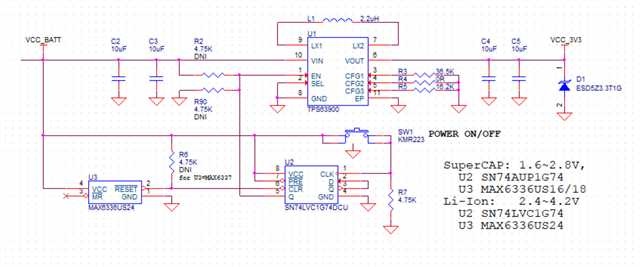Hello: we have a design with SN74LVC1G74DCU as shown in the picture. It is basically a power on/off toggle. All the ICs in the schematic are powered by battery which varies in voltage.
At 2.9V and above, U2 SN74LVC1G74DCU can trigger on and off by the pushbutton.
However, at 2.8V and lower, U2 can't trigger on (i.e., Q doesn't go high). But it can trigger off (i.e., Q goes to low) when it was on.
When U2 is triggered on at 2.9V and above, it stays on (Q=high) when we move down the battery voltage until 2.42V. In other words, U2 shuts off itself at 2.42V. U3 stays on (RESET\=inactive) until the battery voltage is 2.32V. When we move the battery back to 2.42V, U3 MAX6336U24 goes back on (RESET\=inactive) immediately. But U2 SN74LVC1G74DCU can't trigger until the battery is 2.9V.
U3 MAX6336U24 is supposed to reset out when the voltage is 2.4V or low. the measured value 2.32V is normal within the tolerance.
But U2 SN74LVC1G74DCU is supposed to work as low as 1.8V. Why does it drop out at 2.42V and can't trigger at any VCC below 2.9V?
Thanks for help.


